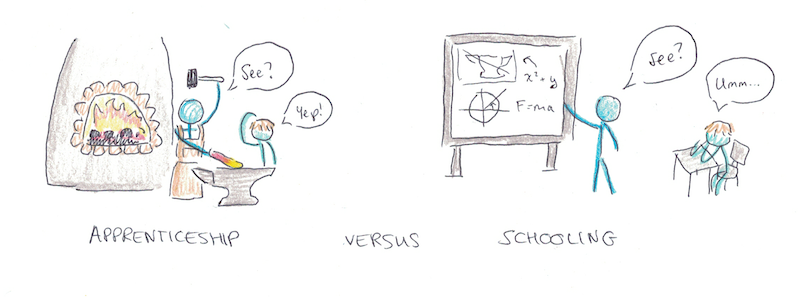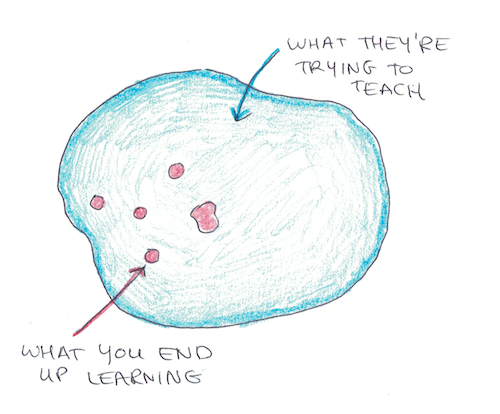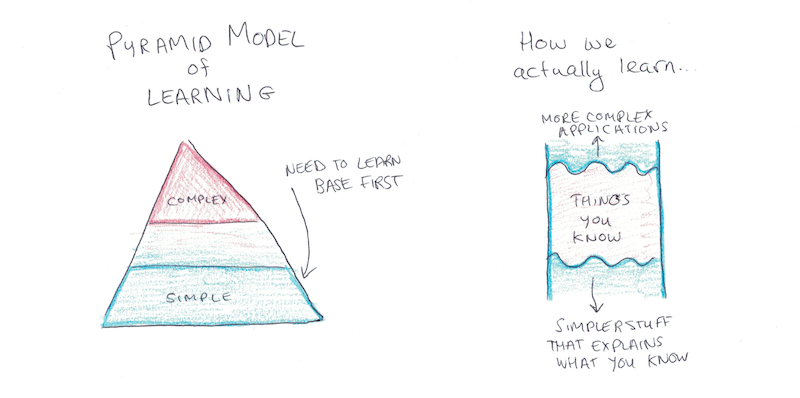We tend to assume that if people today and people five hundred years ago do things differently, it’s because we’ve figured out a better way to do it. After all, we have microscopes, democracy and penicillin. People in the middle ages lit cats on fire for fun.
Yet despite overwhelming progress, it’s ironically in the area of education that we may be the ones who have it backward.

Apprenticeships were, for a long time, the dominant way of learning professional skills. A master agrees to show you how to perform a useful skill. In exchange, he got a bunch of free labor from you while you were learning.
Why Apprenticeships Beat Classrooms
There’s a few good reasons to prefer the apprenticeship model to classes.
1. Transfer is Hard.

The first has to do with transfer. It’s been well-known for decades that learning general abstractions is very hard. Instead, what we learn tends to be hyperspecific. It’s only after learning many hyperspecific things that we get the ability to apply it to completely novel problems.
Consider the findings that economics students tend not to perform better on problems which require economic reasoning, that taking a high-school psychology class doesn’t improve performance in a later psychology class in college, or even more startlingly, that a significant fraction of American high-school graduates can’t calculate the cost of ordering office supplies, given a list.[1][2]
These educational failures are an embarrassment. But they more likely reflect the simple fact about transfer: if you’ve only ever done math, psychology or economics problems in a very narrow setting, you’re unlikely to apply them in the real world, even if you could in principle.
Classes are divorced from the practical applications of learning. Apprenticeships train in exactly the situation you’d want to apply the skill.
2. Learn by Doing (and Watching).

The second reason to prefer apprenticeships is that they more easily mimic how human beings learn almost every other skill we need to survive: by doing and watching.
The doing aspect is obvious, and related to the problem of transfer I described above. The watching aspect is more interesting. Human beings, it appears, are nearly unique in the animal world for being able to learn something by watching somebody else do it.
Joseph Henrich, in his excellent book, The Secret of Our Success, argues that this social learning, not raw intelligence, is what truly separates us from non-human primates or other intelligent animals.
Interestingly, it’s often not so important to actually understand the reasons behind why you should do something as it is to see it being performed correctly. In one interesting study, participants learned through iteration to improve a type of rolling machine, but they couldn’t give an accurate theory why their design worked.
Classrooms don’t follow this principle. Instead, they try to teach broad theories (the why) to eventually make it into the how. Consider medical students, who spend years in the classroom learning theories of chemistry and biology before studying medicine for another few years before working with patients.
Apprenticeships, which focus on practice first, allow you to learn how you were designed to learn. By doing and watching other people.
3. Most Theories are Wrong Anyways.

A lot of people reason on a pyramid model of knowledge. This says all knowledge is built on top of more fundamental layers, with the foundation needing to be bigger than the layer above it or it will collapse. Biology is grounded on chemistry, which is grounded on physics, grounded on math. Our knowledge of physics can’t exceed our knowledge of math.
Except, this model doesn’t work at all. Knowledge isn’t a pyramid. In general, we’re almost always learning from the “middle” of something, with both more complicated theories and more fundamental theories being less well-understood than the central phenomena we started with.
A clear example of this is science itself. We have tons of scientific knowledge. The pyramid approach would say that this must mean we have an ironclad theory of how scientific knowledge is produced. Except we don’t. We have some theories of science, but they’re a lot shakier and contentious than the actual science we created.
Classroom learning tends to be based on the pyramid model. Instead of working directly with a practical example, it argues that we should start by teaching a more abstract theory from which all practical examples can be derived. Learn the rules of conjugation before sentences. Learn Newton’s laws before trying to guess at some practical results of physics. Learn computational theory before coding.
Not all classes are this extreme, but the pyramid model still has a dominant influence in academic learning. Apprenticeships, in contrast, often ignore theory altogether. Which is good, because the theories often aren’t as accurate as the practical knowledge anyways.
How to Create Your Own Apprenticeship
It’s unfortunate that true apprenticeships have gone out of fashion in many fields which could benefit from them. However, if you understand how apprenticeships work, you can try to inject more of the same principles into your own learning.
1. Start by Learning Concrete Things for a Specific Purpose.
The first step is to begin your learning with a specific purpose in mind. Many people think that if they restrict their initial purpose too much, they won’t ever learn fully general skills. In truth, the opposite is closer to the truth. By really learning for a specific purpose, you paradoxically acquire skills that generalize better than if you had started trying to learn everything from first principles.
Examples:
- Learn to code by picking a particular piece of software or script you want to make.
- Learn a language by figuring out exactly where you want to use it (i.e. while traveling in Spain? Watching movies in Japanese? Reading literature in French?)
- Learn history by deciding to write an essay on the military strategies of ancient Rome, rather than by abstractly trying to learn a bunch of history.
2. Theory Builds on Practice, Not the Other Way Around.
Theory is important to learn, but it is more useful after the foundation of practical knowledge has been built. Computational theories after writing code. Grammar after mastering basic sentence patterns. Music theory after learning to play a bunch of songs with your guitar.
The flipside is, theory is actually a lot of fun once you have some foundation in practice. I did the MIT Challenge without having taken more than a couple programming classes in college. But I had spent my high-school days tinkering with little games and applications. For me, the theory-based classes at MIT were perfect, but they might have been a waste of time if I had never tried to make anything before.
3. Immerse Yourself in an Expert Practice Ecosystem.
Immersion in an ecosystem of expert practitioners is one of the best moves you can make for accelerating your learning. Unfortunately, this is often one of the hardest steps to take because these environments are often gated, difficult to access or invisible to the outside.
Ironically, for all my jabs at classroom learning, academia in the graduate levels and beyond is actually this kind of ecosystem! Professors (masters) take in grad students (apprentices) and get them to work for very little money so that they can learn to produce research.
The easiest way to do this is to join an existing practice ecosystem. That could be at a school (research at Harvard), company (machine learning at Google), place (French in France) or even a community (speedrunning through online forums).
If you can’t find it, then you can also make one. When I went to write my first book, I had already made so many friends with other authors that I knew how many processes worked, despite never having published a book myself. The same is true with entrepreneurship. Whenever I have a challenge in my business, I usually know of a few people who are better than I am, and can offer advice.
Learning by doing and learning by watching sound obvious, but they’re often obscured in our classroom-focused style of education. We might not bring back apprenticeships, but by bringing back the features that work, we can all hopefully learn a bit better.
[1] – Haskell, Robert E. Transfer of learning: Cognition and instruction. Elsevier, 2000.
[2] – Caplan, Bryan. The case against education: Why the education system is a waste of time and money. Princeton University Press, 2018.

 I'm a Wall Street Journal bestselling author, podcast host, computer programmer and an avid reader. Since 2006, I've published weekly essays on this website to help people like you learn and think better. My work has been featured in The New York Times, BBC, TEDx, Pocket, Business Insider and more. I don't promise I have all the answers, just a place to start.
I'm a Wall Street Journal bestselling author, podcast host, computer programmer and an avid reader. Since 2006, I've published weekly essays on this website to help people like you learn and think better. My work has been featured in The New York Times, BBC, TEDx, Pocket, Business Insider and more. I don't promise I have all the answers, just a place to start.